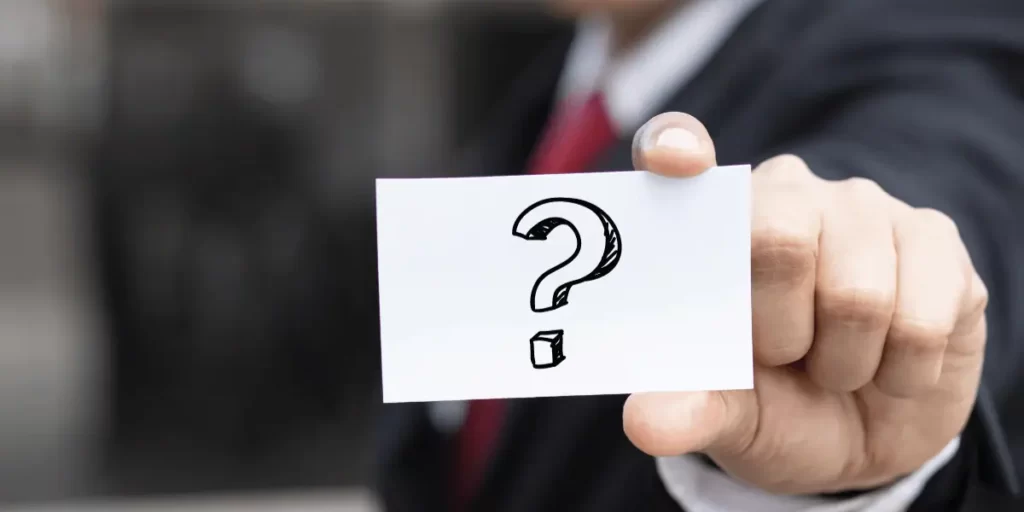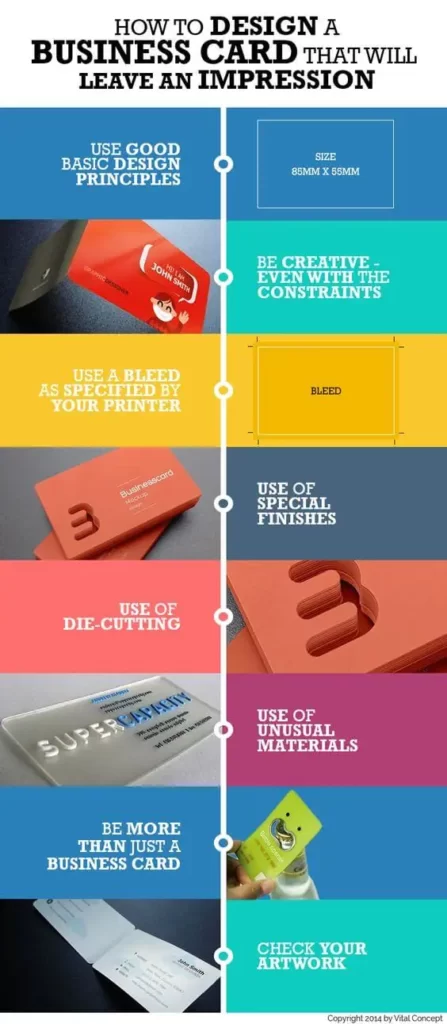The back of your business card is prime real estate that shouldn’t be wasted.
While the front of your card contains your basic contact information, the back offers an opportunity to:
- showcase your brand
- promote your products or services, and
- compel the card recipient to take action.

So what exactly should you put on the reverse side of your business card?
Here are some creative ideas to make the back of your card stand out.
Key Takeaways
Ideas for What to Put on the Back of Your Business Card?
List of Services or Products
Take advantage of the extra space by highlighting your company’s main services, products, or areas of expertise. List these offerings in bullet points or sentences.
This is ideal if your business has an extensive portfolio that won’t fit on the front.
It also serves as a handy reference guide for the cardholder to know exactly what you do.
Company Tagline or Slogan
Including your company tagline or slogan is an impactful branding opportunity. It can succinctly convey your mission, values, or unique selling proposition.
Ensure your tagline stands out through the creative use of color, fonts, or graphics.
Placing it on the back of your card amplifies your core brand message.
Social Media Links
The back of your card presents prime real estate for promoting your social media channels.
List your Instagram handle, Facebook/Twitter usernames, LinkedIn URL, or links to any other platforms where prospects can engage with your brand.
Social media drives brand awareness and sales.

QR Code
A QR code on the back of your business card enables prospects to instantly access your website or specific landing pages using their smartphones.
When scanned, the code can be sent directly to your online portfolio, contact page, special offer, or any webpage you choose.
Customer Testimonials
Positive customer endorsements, centered around your products or services, can generate trust and credibility for your brand.
Quoting brief testimonials on the back of your card provides social proof when prospects flip it over.
Appointment Reminders
Service businesses like salons, spas, or dentists can list helpful appointment reminders on the back of cards.
These could include noting arrival times, bringing previous records, or requirements for first-time clients. This information engages customers and reduces missed bookings.
| Idea | Benefit |
|---|---|
| QR code | Allows recipient to easily scan and save your contact info |
| Social media icons | Directs people to your profiles to learn more about you/your business |
| Coupon code | Incentivizes the recipient to take action and make a purchase |
| Map/directions | Makes it easy for people to find your brick-and-mortar location |
| Calendar or appointment link | Enables recipient to easily schedule time with you |
Loyalty Stamps
Offering loyalty stamps/punch cards is a clever tactic for customer retention.
Providing a basic stamp box on your card’s reverse side gives you built-in branding real estate every time a customer redeems your reward program.
Special Offers or Discounts
Promote time-sensitive discounts, sales, or special promotions on the back of your card to incentivize prospects.
These could relate to first-time customers, email signups, seasonal sales events, or other limited-time offers.
Thank-You Message
A warm, handwritten thank-you note demonstrates thoughtfulness and professionalism.
Pre-print a short appreciation message on the back as a touch customers will remember.

Inspiring Quote
An inspirational or motivational quote relating to your industry helps reinforce your brand identity.
It also provides value for the recipient beyond just your contact details.
Call to Action
Prompt viewers of your card to take their next steps by posing a specific call to action.
This could be “Schedule your free intro session now” or “Sign up for our newsletter“. Provide instructions on how to follow through.
Eye-Catching Imagery
Make your card visually engaging by featuring a large, striking image on the back.
This could showcase your products, office environment, team headshots, infographics, or stylized graphics.
Creative Design
Thinking creatively about shapes, textures, finishes, and folds makes your business card stand out.
Consider rounded edges, foil stamping, or even a shaped die-cut design.
Do’s and Don’ts for the Back of a Business Card
| Do | Don’t |
|---|---|
| Keep it simple | Overcrowd the space |
| Make it scannable | Use tiny fonts or dense text |
| Include only essential info | Put sensitive info like home address |
| Use it strategically | Waste the space with generic info |
| Make sure info is up-to-date | Let links/info become outdated |
Best practices for designing the back of your business card
Keep It Simple and Easy to Read: Clarity is key. Avoid cramming too much text and multiple competing elements that make the back look cluttered.
Use clear fonts and ample spacing between lines or sections.
Use High-Quality Images and Graphics: Any visuals should be crisp and high-resolution.
Don’t use pixelated, distorted, or blurry images/logos that reflect poorly on your brand.
Use Your Brand Colors and Fonts: Ensure all text, logos, and design elements employ your brand’s official colors, typefaces, and graphic style.
This maintains brand consistency.
Make Sure Your Contact Information Is Prominent: While the front of your card should contain your basic contact info, it’s smart to reiterate your phone number, website, or email on the back as well for maximum visibility.
Include a Call to Action: Give the card recipient clear direction by providing a compelling call to action, such as scheduling an appointment or visiting your website.
Proofread Carefully: Double-check for any spelling, grammar, or punctuation errors in your text or logos. These details matter.
Have multiple people proofread before printing.
Did you know?
🚀73% of people say a branded, customized back makes a business card more memorable.
🚀Including a QR code on the back of a card leads to a 158% increase in traffic to a company’s website.
🚀Backs of cards with maps highlighting office locations receive 19% more engagement than plain card backs.
Creative Design Ideas for the Back of Business Cards
Choose a Color Scheme That Matches the Front or Complements It
To project a cohesive, polished brand image, opt for back-of-card colors that align with your front design.
Or, use colors that provide an appealing, complementary contrast.
Use High Quality and Thick Card Stock
A higher quality, thicker card stock elevates the perceived value of your brand.
It also ensures vibrant image reproduction and durability.
Embossing, Foil Stamping, or UV Coating for an Elegant Look
Special finishes like embossing, foil stamping, or UV gloss coating make your card look sleek and luxe.
This treatment can be applied to your logo, text, or graphics.
Die Cut Unique Shapes Like Circles or Ovals
Die-cutting your cards into unique shapes provides a serious wow factor.
Circles, ovals, rounded corners, or asymmetrical cuts make them pop.
Spot Gloss or Matte Finishes, Textured Material
Alternating glossy and matte areas provide visual interest and dimension.
Or, choose textured card stock like linen or cotton for tactile appeal.
Horizontal or Vertical Orientation
Flipping your card’s orientation from horizontal on the front to vertical on the back, or vice versa, adds an unexpected design twist.
Unique Cut Outs or Pop up Elements for 3D Effect
Strategic cutouts or layered pop-up elements create a cool 3D effect.
This interactive design compels viewers to pick up your card and examine it.
Conclusion
A thoughtfully designed back of your business card provides ample opportunities to enhance your brand experience.
By featuring your logo, tagline, offerings, and contact information, it keeps your brand top of mind.
Unique design elements, compelling visuals, and a clear call to action also encourage engagement.
Pay close attention to layout, readability, image quality, and a cohesive style aligned with your brand standards.
With these best practices, your business cards can become an impactful, memorable marketing tool.
Related Posts:
- How to Make Business Cards on Google Docs?
- Are Black Business Cards a Good Idea
- How to Get a Business Credit Card Without a Business?
FAQs On What to Put On the Back of Business Card
What is the best way to format the back of my business card?
The ideal format is clean, simple, and focused on highlighting your brand and key information. Use ample white space and just a few concise sections like your tagline, social media links, and a call to action.
What fonts and colors should I use?
Use your official brand fonts and colors for cohesiveness. Sans serif fonts like Arial, Calibri, or Helvetica work well for readability. Colors should align with your brand palette and contrast well with the card stock.
How can I make my business card stand out?
Eye-catching techniques like foil stamping, unique die cuts, pop-up elements, or vertical orientation help your card be memorable. Likewise, featuring engaging graphics and a compelling call to action helps your card make an impact.
What should I avoid putting on the back of my business card?
Avoid cluttering the space with too much text as it will look messy. Don’t feature low-quality images or generic stock photos that detract from your brand. Stay away from confusing design elements.
How do I design a business card for a specific industry or profession?
Research industry conventions and competitors to inspire ideas tailored to your field. Lawyers often list practice areas on the back, while photographers may showcase photos. Use relevant lingo and imagery.

Rahul is a former medical student turned business blogger who founded NamesPilot to share his passion for entrepreneurship. After successfully launching several online ventures, he now runs his blog full-time, providing tips and insights to help others build their own businesses.



